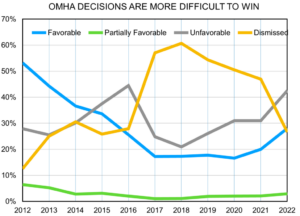Relief for Providers
Adminby Elizabeth E. Hogue, Esq.
Relief for Providers from Devastating Penalties?
A judge in the Northern District of Texas recently decided that even the minimum penalties mandated under the False Claims Act (FCA) violate the Eighth Amendment’s Excessive Fines Clause [see U.S. ex rel. Taylor v. Healthcare Associates of Tex. (N.D. Tex. Feb. 26, 2025)]. The FCA punishes providers for submission of information that is not true in order to get paid by the federal government.
Life Threatening Penalties
The penalties assessed against providers under the FCA may be described as “life threatening.” That is, it may be difficult for providers’ businesses to survive payment of such severe penalties. The minimum penalty increased from $13,946 to $14,308 in 2025. The maximum penalty per claim increased from $27,894 to $28,619.
Ex Post Facto
These increased penalties will be assessed for violations that occurred prior to the change, but that are assessed after they are in effect. These penalties certainly make it clear why it is difficult for providers to survive violations of the FCA.
False Claims
In the Taylor case above, for example, the defendants allegedly submitted false claims as follows:
- As “incident to” a physician’s care without proper documentation
- For services by providers who were not eligible to bill the Medicare Program
- For services performed by medical assistants instead of qualified practitioners

FCA Math Doesn't Add Up
The jury found that one of the defendants, a primary care medical group practice, submitted 21,944 false claims for $2,753,641.86 in actual damages. After trebling the damages as required by the FCA, the Court said it would enter judgement against the defendant for approximately $8 million. The Court acknowledged, however, that penalties under the FCA are fines subject to the Eighth Amendment of the U.S. Constitution.

Grossly Disproportional to the Gravity
The Court then applied the following four factors to decide whether the “fine was grossly disproportional to the gravity of the offense” under the Eighth Amendment:
- The essence of the defendant’s crime and its relationship to other criminal activity
- Whether the defendant was within the class of people for whom the statute of conviction was principally designed
- The maximum sentence, including the fine that could have been imposed
- The nature of the harm resulting from the defendant’s conduct
Fraud...or a Reporting Error?
With regard to the first factor, the Court emphasized that the defendant’s misconduct involved violations of Medicare billing rules, but did not include billing for services that were not provided. In fact, the Court said that even though the defendant violated Medicare billing rules, the misconduct was “closer in gravity to something like a ‘reporting offense.’” There was, said the Court, no evidence that the defendant’s conduct was “related to other criminal or fraudulent activity.
Magnitude of Harm
The Court also focused attention on the fourth factor. The defendant’s harm was certainly significant, but the harm, according to the Court, did not necessitate a penalty “two orders of magnitude greater than the actual financial harm,” especially when the actual damages were substantial, i.e., one hundred times the amount of actual damages. That ratio was “grossly out of alignment with the ratios in other similar cases.” The Court imposed a civil penalty of $8,260,925.58 that represents less than 3% of the statutory minimum.
Final Thoughts
Whether other Courts follow the Taylor case described above remains to be seen, but it is quite clear that providers need relief from the penalties of the FCA.
# # #


Elizabeth Hogue is an attorney in private practice with extensive experience in health care. She represents clients across the U.S., including professional associations, managed care providers, hospitals, long-term care facilities, home health agencies, durable medical equipment companies, and hospices.
©2025 Elizabeth E. Hogue, Esq. All rights reserved.
No portion of this material may be reproduced in any form without the advance written permission of the author.
©2025 by The Rowan Report, Peoria, AZ. All rights reserved. This article originally appeared in The Rowan Report. One copy may be printed for personal use: further reproduction by permission only. editor@therowanreport.com




